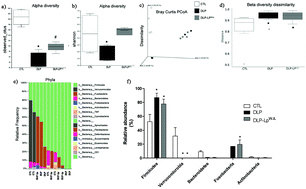Lactiplantibacillus plantarum WJL administration during pregnancy and lactation improves lipid profile, insulin sensitivity and gut microbiota diversity in dyslipidemic dams and protects male offspring against cardiovascular dysfunction in later life
Abstract
Background and aim: Maternal dyslipidemia is recognized as a risk factor for the development of arterial hypertension (AH) and cardiovascular dysfunction in offspring. Here we evaluated the effects of probiotic administration of a specific strain of Lactiplantibacillus plantarum (WJL) during pregnancy and lactation on gut microbiota and metabolic profile in dams fed with a high-fat and high-cholesterol (HFHC) diet and its long-term effects on the cardiovascular function in male rat offspring. Methods and results: Pregnant Wistar rats were allocated into three groups: dams fed a control diet (CTL = 5), dams fed a HFHC diet (DLP = 5) and dams fed a HFHC diet and receiving L. plantarum WJL during pregnancy and lactation (DLP-LpWJL). L. plantarum WJL (1 × 109 CFU) or vehicle (NaCl, 0.9%) was administered daily by oral gavage for 6 weeks, covering the pregnancy and lactation periods. After weaning, male offspring received a standard diet up to 90 days of life. Biochemical measurements and gut microbiota were evaluated in dams. In male offspring, blood pressure (BP), heart rate (HR) and vascular reactivity were evaluated at 90 days of age. Dams fed with a HFHC diet during pregnancy and lactation had increased lipid profile and insulin resistance and showed dysbiotic gut microbiota. Administration of L. plantarum WJL to dams having maternal dyslipidemia improved gut microbiota composition, lipid profile and insulin resistance in them. Blood pressure was augmented and vascular reactivity was impaired with a higher contractile response and a lower response to endothelium-dependent vasorelaxation in DLP male offspring. In contrast, male offspring of DLP-LpWJL dams had reduced blood pressure and recovered vascular function in later life. Conclusion: Administration of L. plantarum WJL during pregnancy and lactation in dams improved gut microbiota diversity, reduced maternal dyslipidemia and prevented cardiovascular dysfunction in male rat offspring.



 Please wait while we load your content...
Please wait while we load your content...